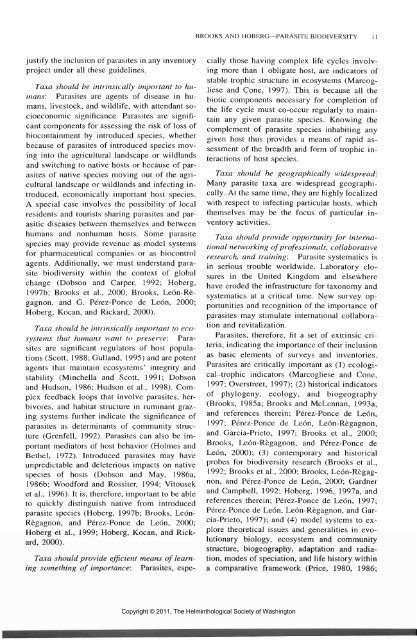Comparative Parasitology 67(1) 2000 - Peru State College
Comparative Parasitology 67(1) 2000 - Peru State College
Comparative Parasitology 67(1) 2000 - Peru State College
Create successful ePaper yourself
Turn your PDF publications into a flip-book with our unique Google optimized e-Paper software.
justify the inclusion of parasites in any inventory<br />
project under all these guidelines.<br />
Taxa should be intrinsically important to humans:<br />
Parasites are agents of disease in humans,<br />
livestock, and wildlife, with attendant socioeconomic<br />
significance. Parasites are significant<br />
components for assessing the risk of loss of<br />
biocontainment by introduced species, whether<br />
because of parasites of introduced species moving<br />
into the agricultural landscape or wildlands<br />
and switching to native hosts or because of parasites<br />
of native species moving out of the agricultural<br />
landscape or wildlands and infecting introduced,<br />
economically important host species.<br />
A special case involves the possibility of local<br />
residents and tourists sharing parasites and parasitic<br />
diseases between themselves and between<br />
humans and nonhuman hosts. Some parasite<br />
species may provide revenue as model systems<br />
for pharmaceutical companies or as biocontrol<br />
agents. Additionally, we must understand parasite<br />
biodiversity within the context of global<br />
change (Dobson and Carper, 1992; Hoberg,<br />
1997b; Brooks et al., <strong>2000</strong>; Brooks, Leon-Regagnon,<br />
and G. Perez-Ponce de Leon, <strong>2000</strong>;<br />
Hoberg, Kocan, and Rickard, <strong>2000</strong>).<br />
Taxa should be intrinsically important to ecosystems<br />
that humans want to preserve: Parasites<br />
are significant regulators of host populations<br />
(Scott, 1988; Gulland, 1995) and are potent<br />
agents that maintain ecosystems' integrity and<br />
stability (Minchella and Scott, 1991; Dobson<br />
and Hudson, 1986; Hudson et al., 1998). Complex<br />
feedback loops that involve parasites, herbivores,<br />
and habitat structure in ruminant grazing<br />
systems further indicate the significance of<br />
parasites as determinants of community structure<br />
(Grenfell, 1992). Parasites can also be important<br />
mediators of host behavior (Holmes and<br />
Bethel, 1972). Introduced parasites may have<br />
unpredictable and deleterious impacts on native<br />
species of hosts (Dobson and May, 1986a,<br />
1986b; Woodford and Rossiter, 1994; Vitousek<br />
et al., 1996). It is, therefore, important to be able<br />
to quickly distinguish native from introduced<br />
parasite species (Hoberg, 1997b; Brooks, Leon-<br />
Regagnon, and Perez-Ponce de Leon, <strong>2000</strong>;<br />
Hoberg et al., 1999; Hoberg, Kocan, and Rickard,<br />
<strong>2000</strong>).<br />
Taxa should provide efficient means of learning<br />
something of importance: Parasites, espe-<br />
BROOKS AND HOBERG—PARASITE BIODIVERSITY<br />
cially those having complex life cycles involving<br />
more than 1 obligate host, are indicators of<br />
stable trophic structure in ecosystems (Marcogliese<br />
and Cone, 1997). This is because all the<br />
biotic components necessary for completion of<br />
the life cycle must co-occur regularly to maintain<br />
any given parasite species. Knowing the<br />
complement of parasite species inhabiting any<br />
given host thus provides a means of rapid assessment<br />
of the breadth and form of trophic interactions<br />
of host species.<br />
Taxa should be geographically widespread:<br />
Many parasite taxa are widespread geographically.<br />
At the same time, they are highly localized<br />
with respect to infecting particular hosts, which<br />
themselves may be the focus of particular inventory<br />
activities.<br />
Taxa should provide opportunity for international<br />
networking of professionals, collaborative<br />
research, and training: Parasite systematics is<br />
in serious trouble worldwide. Laboratory closures<br />
in the United Kingdom and elsewhere<br />
have eroded the infrastructure for taxonomy and<br />
systematics at a critical time. New survey opportunities<br />
and recognition of the importance of<br />
parasites may stimulate international collaboration<br />
and revitalization.<br />
Parasites, therefore, fit a set of extrinsic criteria,<br />
indicating the importance of their inclusion<br />
as basic elements of surveys and inventories.<br />
Parasites are critically important as (1) ecological-trophic<br />
indicators (Marcogliese and Cone,<br />
1997; Overstreet, 1997); (2) historical indicators<br />
of phylogeny, ecology, and biogeography<br />
(Brooks, 1985a; Brooks and McLennan, 1993a,<br />
and references therein; Perez-Ponce de Leon,<br />
1997; Perez-Ponce de Leon, Leon-Regagnon,<br />
and Garcia-Prieto, 1997; Brooks et al., <strong>2000</strong>;<br />
Brooks, Leon-Regagnon, and Perez-Ponce de<br />
Leon, <strong>2000</strong>); (3) contemporary and historical<br />
probes for biodiversity research (Brooks et al.,<br />
1992; Brooks et al., <strong>2000</strong>; Brooks, Leon-Regagnon,<br />
and Perez-Ponce de Leon, <strong>2000</strong>; Gardner<br />
and Campbell, 1992; Hoberg, 1996, 1997a, and<br />
references therein; Perez-Ponce de Leon, 1997;<br />
Perez-Ponce de Leon, Leon-Regagnon, and Garcia-Prieto,<br />
1997); and (4) model systems to explore<br />
theoretical issues and generalities in evolutionary<br />
biology, ecosystem and community<br />
structure, biogeography, adaptation and radiation,<br />
modes of speciation, and life history within<br />
a comparative framework (Price, 1980, 1986;<br />
Copyright © 2011, The Helminthological Society of Washington
















